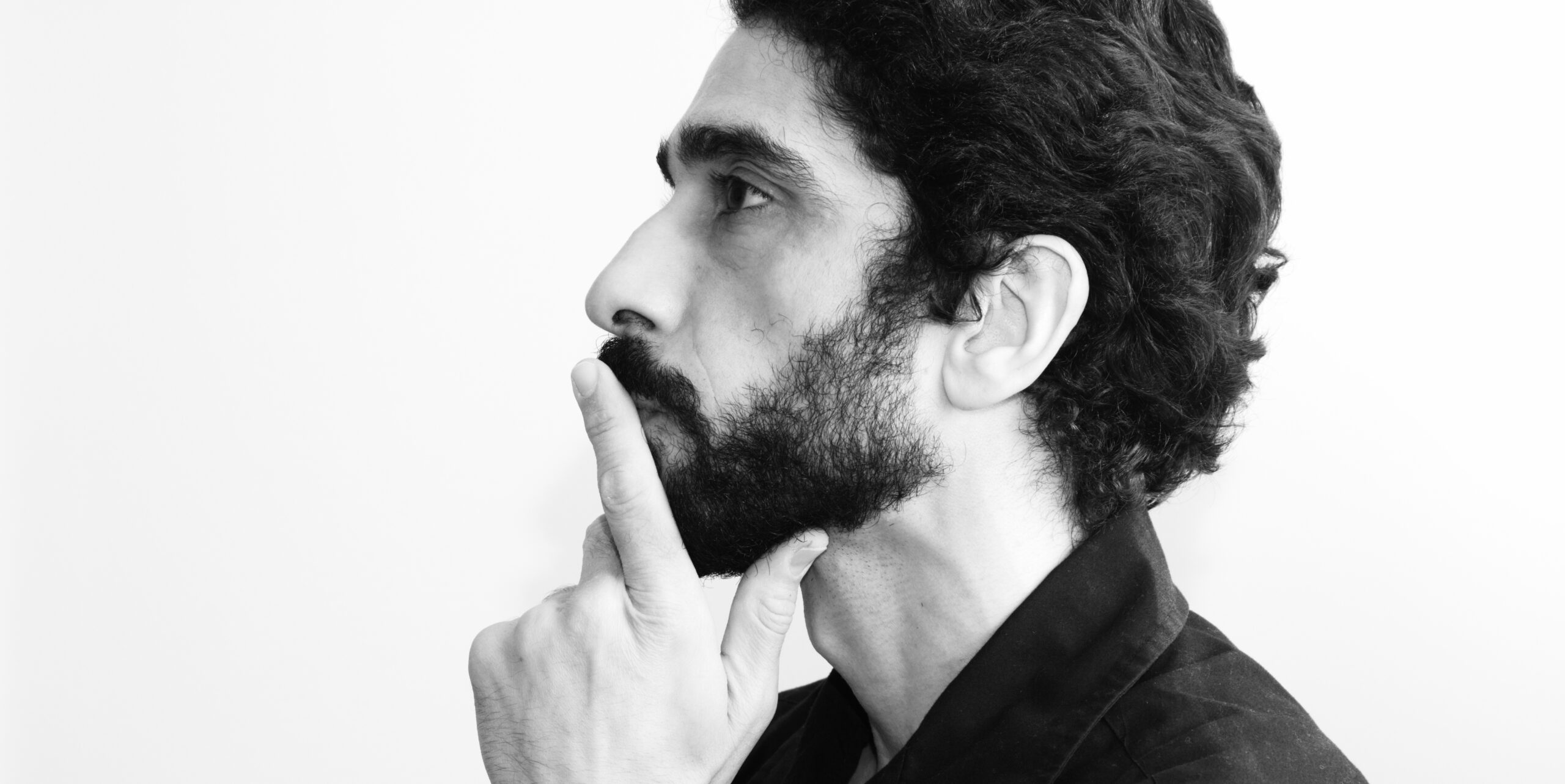It’s been nearly a month since I put up the bird feeders in our house and I have been enjoying them nearly every day since then. In fact, the only negative has been the cost of bird food. But, as my mother-in-law put it, I get the benefits of having birds without the hassle of having them as pets. At first we had a few birds visiting the feeders each day. Now, during the busy bird breakfast hours, we get multiple birds at once. Interestingly, on the whole, the birds to not fight with each other. Rather, if there are more birds than spots at the feeder, they will queue up on nearby branches. I was very surprised by this behaviour because I thought they would surely fight over this nearly infinite food source.
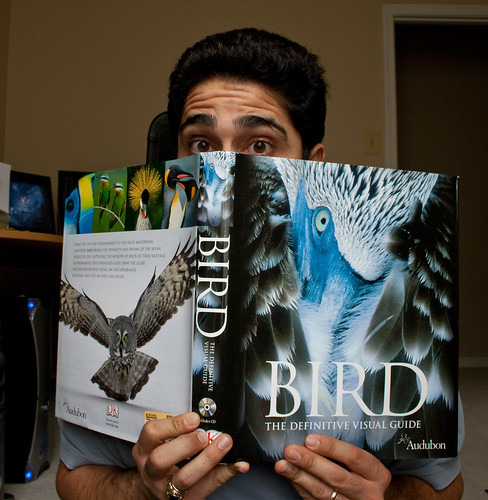
Using BIRD: The definitive guide, I have been able to ID some of the birds coming to the feeder. One of the main birds we get is the black-capped chickadee. These little birds tend to flit out, grab a bite, and return to the wooded area. They also tend to prefer the yellow bird feeder which exclusively contains sunflower seeds. Interestingly, although the yellow bird feeder would probably hold around six or so Black-capped chickadees, they tend to visit one at a time or in pairs on opposite ends of the feeder. Every once in a while they’ll be at 90 degree angles from each other and start chirping at each other, but don’t appear to be actively fighting.

The second most numerous visitors are little brown birds that appear to be sparrows. (I haven’t positively ID’d them) Interestingly, unlike the Black-capped chickadees, the sparrows seem to not have any problems congregating together. Unlike the chickadees, they will often come out in a large group. While four of them take up perches on the red bird feeder, another four may perch on a branch behind the bird feeder and wait their turn.
The next group of birds are pigeons. We have some brown pigeons (not the grey city ones) that like to come eat the bird food I set out. In studying my new interest of ornithology, I have learned that passerines are perching birds. Black-capped chickadees are passerines. Pigeons are near passarines so perhaps they don’t like to perch as much? Or, more likely, the pigeons realize that the perches on my bird feeder are probably too small for them; that would definitely be a good skill for birds to posses. They, therefore, linger on the ground and eat the bird food that falls as the perching birds eat. Quite a bit falls to the ground, so they get to eat a lot.

The least common bird was the one for whom I erected the bird feeder. We had glimpsed the Cardinal in our wooded area whenever it would come to the outer branches. Unfortunately, that rarely happened and I really wanted to capture the bird on [digital] film. The interesting thing is that there appear to only be three of them, and before building the bird feeder I had never seen the Black-capped chickadees, sparrows, or pigeons in my backyard. The male cardinal appears to be a pretty temperamental bird. Last weekend we witnessed him attempting to have the sparrow branch all to himself. He landed in an empty spot on the branch with sparrows to either side of him. He the proceeded to attempt to peck the sparrow near him and it flew away. (Don’t know if he would have gone through with it or was just bluffing) Thanks to the BIRD book, I was able to realize that a brown bird in the area was likely a female cardinal. Another cardinal that shows up may either be a female or a juvenile. Just like the pigeons, the cardinals tend to eat the bird food on the floor. Unlike the pigeons, the cardinals tend to hop around trying to scare away the pigeons and sparrows. Both the male and female appear to be just as aggressive.
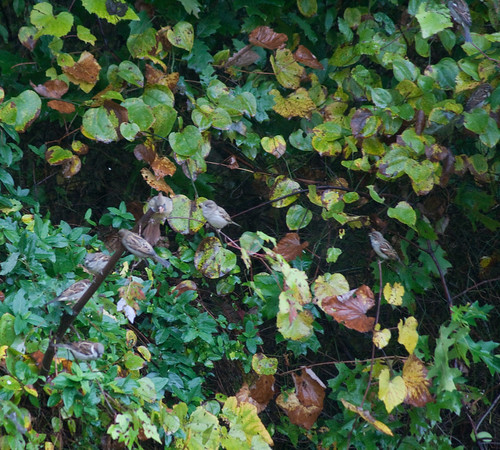
We haven’t seen any American robins for the last few months. Before, that was the only bird I thought we had in the neighborhood. Checking wikipedia (and later the BIRD book) confirms they have flown south for the winter. It will be interesting to see how the competition for the bird food increases when they return.
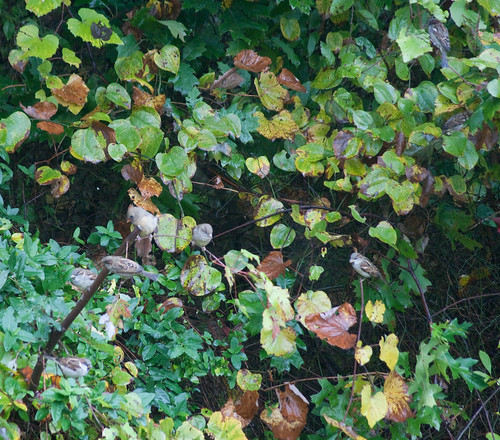
There is another blueish/greyish bird that visits the feeder, but I haven’t been able to get a good shot of it yet. It’s bigger than the chickadees and sparrows, but not so big that it hesitates to use the yellow bird feeder.
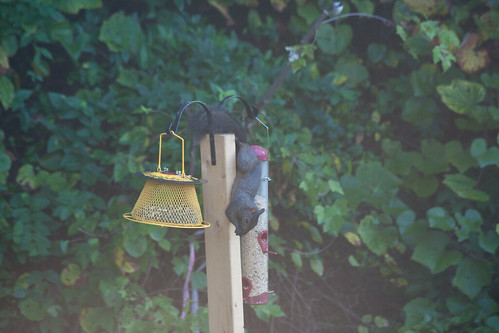
On the negative side of this whole experience are three squirrels who continually raid the bird feeders. They climb to the top of the wood plank holding up the bird feeders, hang upside-down, and gorge on the food there. Although I’m a fan of squirrels, this irks me for a few reasons. First of all, they eat a lot more food than the birds and are contributing to the escalating cost of the bird food. Second, while they’re feeding on the bird food, most of the birds are hesitant to feed. I put the bird feeders up to see birds, not to see squirrels. I have seen some birds attempt to scare the squirrel away, but it appears not to care.

This weekend we also noticed one of the free-range cats in our neighborhood has taken notice of the bird feeder. It attempted to hide in the wooded area, but the birds were smart enough not to feed on the floor until the cat was gone. While it was amusing to see the cat’s face as it tried to track the birds, I certainly don’t want to contribute to raptorcide, so I wanted the cat to go away. Luckily, cats have ADD, so it left after a few minutes and the birds returned.
Another thing I’ve noticed is that birds will come to feed at a distance that also scares them away. So, if there are the usual 20 or so birds in the area of the bird feeder and I stroll to the bottom of my deck stairs, they will all scatter. But if I stay still, they will begin to return to feed. Are they getting used to humans as OK or are they just hungry enough to eat until I move again? The black-capped chickadees appear to be the most apathetic towards my presence. Interestingly, some came to feed while I was mowing the lawn nearby. Of course, they didn’t linger as much as usual, but they did go eat.
So far, I’d have to say I’m pretty happy with the results of the feeders. If there’s one thing I have not outgrown from my childhood, it’s a fascination with animals. I love all their little quirks. I get way too excited for someone in his mid-twenties when cardinals hop around the yard or cock their heads in that distinctly bird-like way. So having these all these birds in my yard has been wonderful from that perspective.
Also, as someone who enjoys wildlife photography, it has been a real boon. In the last month my bird photography skills have considerably improved. I’ve come to learn techniques to enhance my chances of getting a good shot. Also, now that it’s not so rare to get a bird shot, I can try and focus on composition and not worry that I’ve missed my one good shot at a cardinal. I still have a long way to go, but I think I’m on a good path for bird photography. With what I learn here, I’ll be better off next time I go to Florida or some other bird mecca. Right now I shoot with the Tamron 55-200mm f4-5.6 Di II LD, which is pretty much just below the limit for bird photography. While I can get some pretty good shots in the distance from my deck to the bird feeder, my only chance of filling the frame is to crop the photo … a lot. I’m hoping to have enough money saved up by this February to afford the Sigma 120-400mm f4.5-5.6 HSM DG OS. The doubling of focal length should at least double my reach. (Although something I read suggested it might quadruple it!) I still think I’ll probably have to crop my photos, but the less I crop, the better chance of having a photo that can be enlarged to a reasonable size.
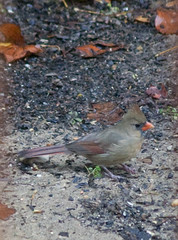
In fact, apart from the expense of bird food, the only negative to this whole little experiment is that it’s a huge distraction for Danielle and I. Although I still have to lift it about a foot higher so we can enjoy it while seated in the nook, we will often find that the other person is only half paying attention to any given conversation taking place while the birds feed.
I fully recommend to anyone who enjoys watching birds or photographing them that they should build or purchase a bird feeder. You get to enjoy them and it draws them out of the woods so you don’t have to hunt for them. I recommend placing it high enough that a cat cannot reach the birds by jumping. Also, it may be worth keeping it away from the house in order to avoid attracting mice to the house. So far, my initial stock of food cost about $10 and ran out in 3 weeks. I bought bigger bags for $20 and some tubs for $30. I expect to spend about $20 a month, but that’s pretty cheap compared to dogs and cats. And, since the birds aren’t mind, I don’t have to clean up cages or take them to the vet if they get sick.
